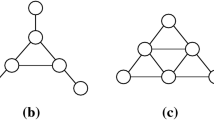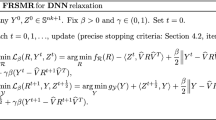Abstract
In this paper we consider the relaxation of the corner polyhedron introduced by Andersen et al., which we denote by RCP. We study the relative strength of the split and triangle cuts of RCP’s. Basu et al. showed examples where the split closure can be arbitrarily worse than the triangle closure under a ‘worst-cost’ type of measure. However, despite experiments carried out by several authors, the usefulness of triangle cuts in practice has fallen short of its theoretical strength.
In order to understand this issue, we consider two types of measures between the closures: the ‘worst-cost’ one mentioned above, where we look at the weakest direction of the split closure, and the ‘average-cost’ measure which takes an average over all directions. Moreover, we consider a natural model for generating random RCP’s. Our first result is that, under the worst-cost measure, a random RCP has a weak split closure with reasonable probability. This shows that the bad examples given by Basu et al. are not pathological cases. However, when we consider the average-cost measure, with high probability both split and triangle closures obtain a very good approximation of the RCP. The above result holds even if we replace split cuts by the simple split or Gomory cuts. This gives an indication that split/Gomory cuts are indeed as useful as triangle cuts.
Access this chapter
Tax calculation will be finalised at checkout
Purchases are for personal use only
Preview
Unable to display preview. Download preview PDF.
Similar content being viewed by others
References
Andersen, K., Louveaux, Q., Weismantel, R., Wolsey, L.A.: Inequalities from two rows of a simplex tableau. In: Fischetti, M., Williamson, D.P. (eds.) IPCO 2007. LNCS, vol. 4513, pp. 1–15. Springer, Heidelberg (2007)
Balas, E.: Intersection cuts-a new type of cutting planes for integer programming. Operations Research 19(1), 19–39 (1971)
Balas, E., Qualizza, A.: Personal communication
Balas, E., Saxena, A.: Optimizing over the split closure. Mathematical Programming, Series A 113(2), 219–240 (2008)
Basu, A., Bonami, P., Cornuéjols, G., Margot, F.: Experiments with two-row cuts from degenerate tableaux. To appear in INFORMS Journal on Computing, doi:10.1287/ijoc.1100.0437
Basu, A., Bonami, P., Cornuéjols, G., Margot, F.: On the relative strength of split, triangle and quadrilateral cuts. Mathematical Programming, Series A 126, 281–314 (2011)
Basu, A., Cornuéjols, G., Molinaro, M.: A probabilistic comparison of split, triangle and quadrilateral cuts for two row mixed-integer programs (extended version), http://www.optimization-online.org/DB_HTML/2010/10/2770.html
Borozan, V., Cornuéjols, G.: Minimal valid inequalities for integer constraints. Mathematics of Operations Research 34(3), 538–546 (2009)
Cornuéjols, G., Margot, F.: On the facets of mixed integer programs with two integer variables and two constraints. Mathematical Programming, Series A 120, 429–456 (2009)
Dey, S.S., Lodi, A., Tramontani, A., Wolsey, L.A.: Experiments with two row tableau cuts. In: Eisenbrand, F., Shepherd, F.B. (eds.) IPCO 2010. LNCS, vol. 6080, pp. 424–437. Springer, Heidelberg (2010)
Espinoza, D.G.: Computing with multi-row gomory cuts. Operations Research Letters 38(2), 115–120 (2010)
Gomory, R.E.: Some polyhedra related to combinatorial problems. Linear Algebra and its Applications 2(4), 451–558 (1969)
He, Q., Ahmed, S., Nemhauser, G.: A probabilistic comparison of split and type 1 triangle cuts for two row mixed-integer programs. Working paper, School of OR&IE, Goergia Tech (2009), http://www.optimization-online.org/DB_HTML/2010/06/2636.html
Del Pia, A., Wagner, C., Weismantel, R.: A probabilistic comparison of the strength of split, triangle, and quadrilateral cuts. Working paper, ETH Zürich (September 2010), http://arxiv.org/abs/1009.5253
Author information
Authors and Affiliations
Editor information
Editors and Affiliations
Rights and permissions
Copyright information
© 2011 Springer-Verlag Berlin Heidelberg
About this paper
Cite this paper
Basu, A., Cornuéjols, G., Molinaro, M. (2011). A Probabilistic Analysis of the Strength of the Split and Triangle Closures. In: Günlük, O., Woeginger, G.J. (eds) Integer Programming and Combinatoral Optimization. IPCO 2011. Lecture Notes in Computer Science, vol 6655. Springer, Berlin, Heidelberg. https://doi.org/10.1007/978-3-642-20807-2_3
Download citation
DOI: https://doi.org/10.1007/978-3-642-20807-2_3
Publisher Name: Springer, Berlin, Heidelberg
Print ISBN: 978-3-642-20806-5
Online ISBN: 978-3-642-20807-2
eBook Packages: Computer ScienceComputer Science (R0)




